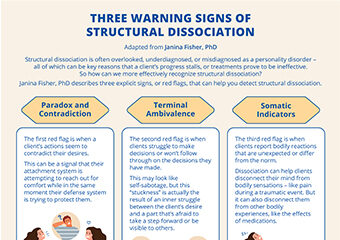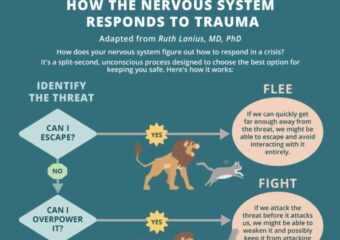Like many of the emerging defense responses to trauma, the collapse/submit response can be difficult to recognize. So to give you a clearer idea of what this trauma response can look like, we created this free infographic that highlights four key ways it might present in a client. To put this infographic together, we gathered […]
[Infographic] – Three Warning Signs of Structural Dissociation
Working with structural dissociation can be critical in the treatment of severe or prolonged trauma . . . . . . but it’s often difficult to detect. According to Janina Fisher, PhD, structural dissociation is commonly underdiagnosed, or it’s misdiagnosed as a personality disorder. And when left undetected, it could lead to ineffective treatments that […]
[Infographic] – How the Nervous System Responds to Trauma
It can often be difficult for trauma survivors to understand how or why they reacted a certain way during a traumatic experience. Instead of seeing their trauma response as the result of a split-second, unconscious decision made by their nervous system, your client may blame themself for not reacting differently. This can be especially true […]
Working with Self-Harm: Pat Ogden, PhD with a Safe Replacement for Harmful Actions
In the aftermath of trauma, some clients turn to self-harm to relieve intense feelings of shame, anxiety, or even emotional numbness. Over time, these harmful behaviors can become addictive – and helping clients break that cycle can be a challenging process. So in the video below, Pat Ogden, PhD explains how she helps clients gain […]
Working with the Freeze Response in the Treatment of Trauma with Stephen Porges, PhD
When a client freezes during a session, how do you help them come out of their trauma response (without further triggering them)? This can be challenging because proximity, movement, and eye contact can all feel threatening to a client who is frozen and hyper-aware of danger. So in the video below, Stephen Porges, PhD, shares […]




